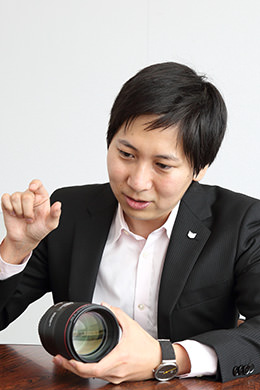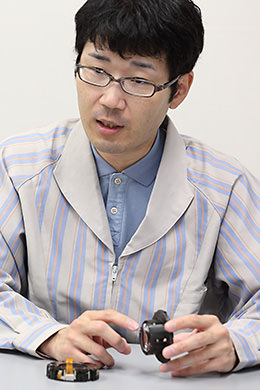In the 2nd part of our interviews with the developers of Canon’s new EF85mm f/1.4L IS USM lens (Part 1 here), we learn more about the unique features in the optical and mechanical design of an L-series lens.

The optical arrangement makes the best use of the large diameter EF mount

EOS 5D Mark IV/ EF85mm f/1.4L IS USM/ FL: 85mm/ Manual exposure(f/1.4, 1/2500sec)/ ISO 200/ WB: Auto
An image that is not only in sharp focus, but also carries a beautiful bokeh in the background. This is possible because of the large diameter EF mount, which provides a maximum aperture of f/1.4.
Iwamoto: Due to the nature of optical design, the further the diaphragm (EMD unit) is from the rear of the optical system (i.e., the mount side), the larger the rear lens diameter must be. On the other hand, as mentioned earlier [see Part 1], since the image stabilisation unit is also positioned on the mount side, the components must be arranged in the following order:
(Lens front) Diaphragm - Image stabilisation unit - Rear lens group (Camera)
Since the diaphragm is located relatively far from the mount, the diameter of the rear lens group has to be larger. Large aperture lenses already have a large diameter, and this tends to increase even further when equipped with image stabilisation, so the rearward positioning of the diaphragm is important. It was difficult to configure the stabilising optical system and the rear lens group with as few lenses as possible, while ensuring that optical performance is maintained.


The EF85mm f/1.4L IS USM (left) is designed to make the best of the large, 54mm-diameter EF mount (right).
As a result, the lens diameter just barely fits the EF mount. If you actually hold the lens and look at it through the mount side, you should be able to see just how big the lens diameter actually is. The large diameter EF mount made this configuration possible, and this was how we managed to equip the lens with image stabilisation.

Fig.1 EF85mm f/1.2L II USM optical arrangement
Once the configuration of the image stabilisation unit was decided, we moved on to decide the optimum configuration for the focus group, and then on the configuration of the entire lens. In order to reduce the size of the entire lens, both the focus group and image stabilising optics had to be lightweight and only move a small amount. For this lens, we used the following new optical arrangement from the front of the lens: the front group, followed by the focus group, the diaphragm, the stabilisation group and then the rear group.
The properties of the focus group and the stabilisation group change greatly depending on whether they are convex or concave lens groups. By configuring the focus group as a convex lens group and the stabilisation group as a concave lens group, and then positioning them adjacently to each other so that the concave and convex characteristics neutralize each other, the respective refractive powers can be set appropriately. This was how we managed to both the entire lens body as well as the image stabilisation group more compact.
In addition, by configuring the focus group in a convex-concave-convex lens arrangement, both weight reduction and high image quality were achieved. Furthermore, by configuring the rear group with an aspherical lens, we reduced the number of lenses in the rear group while correcting spherical aberration, allowing us to position the diaphragm as far back as possible. By devising the basic configuration of the entire lens and the configuration of each lens group in this way, we managed to achieve our design goals.

Fig.2 EF85mm f/1.4L IS USM optical arrangement
As the addition of the image stabilisation group increases the total number of lens elements, the suppression of ghosting was another technical problem we needed to overcome. For this lens, we used a three- element cemented lens for the rear lens. It is difficult to precisely align the axes of the three lenses in a three element-cemented lens, but we decided to use it to reduce the air contact surface, especially since the lens surfaces on the rear lens were particularly prone to ghosting. Thus, by using ASC (Air Sphere Coating) for the 8th lens, we were able to suppress ghosting even with the increase in the number of lens elements.
Aiming for significant size reduction
Okuda: Ultrasonic motors (USMs), which are the actuators that drive autofocus, come in several options to match the lens diameter. To keep the outer diameter small enough for extended handheld shooting, we decided to use a relatively small type of USM, which is used in many other EF lenses including the EF35mm f/2 IS USM and EF85mm f/1.8 USM. Starting with the optical system, we worked with the optical design lead to come up with a design where the components would fit within the limited USM diameter.
For your reference, the EF85mm f/1.2L II USM uses the large diameter USM found in lenses such as the EF400mm f/2.8L IS II USM super-telephoto lens.

Fig.3 Ring USM (USM used by the EF85mm f/1.4L IS USM on the right)
As mentioned earlier (see Part 1), though the image stabilisation group of this lens is similar in size and weight to that of a super-telephoto lens, we needed to ensure that the entire image stabilisation unit, including the drive system, was reasonably-sized. For that reason, we reduced drive load by using an extremely low-friction drive mechanism that uses multiple ceramic bearings to support movable components. This reduces the needed drive force and contributes to a compact and lightweight image stabilisation unit design.

Fig.4 Image stabilisation unit comparison
Left: Actual unit, Right: Comparison units
A focus drive mechanism (Fig. 5) on the front side of the image stabilisation unit was devised as well. Since it is a large aperture lens, depth-of-field is very shallow and autofocus also requires extremely high accuracy. Not surprisingly, the focus lens group is also heavy and the the entire drive mechanism, such as the motor that drives the group and the brake control that stops it, needed to be made more durable than even that for other L-series lenses. Using highly durable ball bearings in the drive mechanism for this lens reduces load and improves resolution while also improving accuracy. The use of ball bearings also contributes to high-speed autofocus. The heavy focus lens group must be driven with the limited power of the motor, but the focus lens can be driven quickly since the ball bearings reduce the load.

Fig.5 Focusing unit (ball bearings in a square)
By making the shape of the mechanical components of the ring USM unit follow the outer diameter of the glass, space efficiency was maximized, which contributed to size and weight reduction.
In order to overcome the unusual difficulty of adding an image stabilisation mechanism to an 85mm f/1.4 lens while ensuring an appealing size and weight, we invested a great deal of time examining the combination of mechanics and optics. By reducing the mechanical components by 0.1 millimetre at a time, we finally achieved a lens design that was suited for practical use.
This lens has achieved an image stabilisation effect of 4 stops (85mm focal length, using an EOS-1D X Mark II. CIPA standards compliant). This is the first f/1.4 large aperture Canon lens to be equipped with image stabilisation, and we hope that users will experience for themselves the ease-of-use brought about by our achievement of keeping the lens size practical while equipping it with IS.
Dedicated to reliability
Okuda: Although we devised solutions for a lightweight design, impact force, such as when dropped, will be significant as the lens is still close to 1 kg. To improve reliability, we implemented a damper mechanism of the front of the lens. The filter holder is shaped to retract when pushed—this is quite obvious when you actually handle the lens. The damper distributes the impact when something collides with the end of the lens. It is characteristically difficult to distribute shock when the length is of a fixed length. We decided to use a damper since this is a fixed length lens with a large aperture. This is not used for all EF lenses, but is used as needed based on lens configuration and simulations. In addition to this lens, the damper is also used with the EF24-70mm f/4L IS USM, EF11-24mm f/4L USM, EF35mm f/1.4L II USM and EF24-105mm f/4L IS II USM. Although it may not be very obvious with a zoom lens, you should be able to tell when you push the filter holder on a prime lens.

Dust-proof, drip-proof sealing and construction is used in and around the mount, switches, and focusing ring of the EF85mm f/1.4L IS USM.
Conclusion
Yamaguchi: While the demands for greater pixel counts will increase in the coming years, a highly usable lens will allow users to photograph handheld with a sense of security. We can confidently recommend this outstanding lens that, as a portrait lens, was completed with an excellent balance of resolution, image stabilisation, weight and size.
When shooting indoors or in dim light, this lens allows you to capture sharp images without the need to increase the ISO setting. You can now enjoy handheld portrait shooting without getting tired thanks to the light weight and image stabilisation. We hope that this lens will enable users to experience the greater range expression that was previously not possible.

Yamaguchi, Product Planning Lead

Iwamoto, Optical Design Lead

Okuda, Mechanical Design Lead
Receive the latest update on photography news, tips and tricks.
Be part of the SNAPSHOT Community.
Sign Up Now!

































